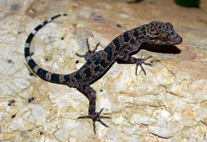Abstract
Four new species of Badis are described from West Bengal, India. Badis andrewraoi, new species, is diagnosed by a combination of characters which include absence of a black caudal-fin margin, absence of a conspicuous dark blotch on pectoral-fin base, absence of cleithral and opercular blotches, absence of a blotch on the dorsolateral aspect of the caudal peduncle, absence of an ocellus on the caudal-fin base, presence of a conspicuous median black caudal peduncle blotch, a medially broader posterior-most bar, displaying as a partially absorbed second median caudal peduncle blotch, presence of an additional bar anteriorly, and vertical bars restricted to lower half of body and never forming large blocks. Badis autumnum, new species, is diagnosed by a combination of characters which include two autapomorphies: presence of a blotch above the base of the opercular spine, and of a conspicuous dark blotch on pectoral-fin base. Additionally, it presents a black caudal-fin margin, outlining entire fin, absence of a cleithral blotch, absence of a blotch on the dorsolateral aspect of the caudal peduncle, absence of an ocellus on the caudal-fin base, presence of a conspicuous median black caudal peduncle blotch, a medially broader posterior-most bar, displaying as a partially absorbed second median caudal peduncle blotch, and presence of an additional bar anteriorly. Badis kyanos, new species, is diagnosed by a combination of characters which include absence of a conspicuous dark blotch on pectoral-fin base, absence of cleithral and opercular blotches, absence of a blotch on the dorsolateral aspect of the caudal peduncle, absence of an ocellus on the caudal-fin base, presence of a conspicuous median black caudal peduncle blotch, a medially broader posterior-most bar, displaying as a partially absorbed second median caudal peduncle blotch, presence of an additional bar anteriorly, its vertical bars forming large, fragmented black blocks dorsolaterally and ventrolaterally, and a unique stress colouration consisting of a dark grey body, metallic dark blue operculum, flanks almost entirely devoid of bars, large, fragmented black blocks dorsolaterally, and absence of a black caudal-fin margin. Based on similarities in colour pattern and biometrics they are deduced to be closely related and form a new species group, which we herein define. The three species are divergent and diagnosable from each other and represent valid evolutionary species. The fourth species represents a cryptic unit that was heretofore unrecognised and considered as the most widespread species of the genus, B. badis. We describe this lineage as Badis soraya, new species, and find it belongs to the B. badis species group. It can be diagnosed by a combination of characters which include absence of opercular blotches, absence of a blotch on the dorsolateral aspect of the caudal peduncle, absence of an ocellus on the caudal-fin base, presence of a cleithral blotch, presence of a small oval black blotch medially on caudal peduncle, interorbital width 6.3–8.8 % SL, dorsal-fin spines XIV–XVI, scales in lateral row 25–27, and vertebrae number 27.

